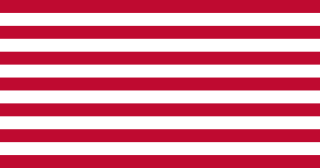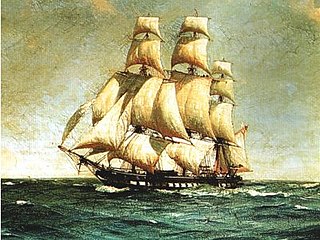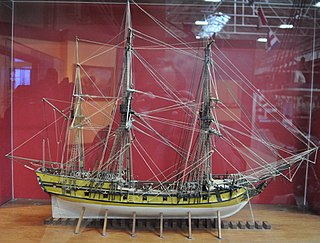
The second USS Boston was a 24-gun frigate, launched 3 June 1776 by Stephen and Ralph Cross, Newburyport, Massachusetts, and completed the following year. In American service she captured a number of British vessels. The British captured Boston at the fall of Charleston, South Carolina, renamed her HMS Charlestown, and took her into service. She was engaged in one major fight with two French frigates, which she survived and which saved the convoy she was protecting. The British sold Charlestown in 1783, immediately after the end of the war.

The Continental Navy was the navy of the Thirteen Colonies during the American Revolutionary War. Founded on October 13, 1775, the fleet developed into a relatively substantial force throughout the Revolutionary War, owing partially to the substantial efforts of the Continental Navy's patrons within the Continental Congress. These Congressional Patrons included the likes of John Adams, who served as the Chairman of the Naval Committee until 1776, when Commodore Esek Hopkins received instruction from the Continental Congress to assume command of the force.
HMS Orestes was an 18-gun Dutch-built brig-sloop of the Royal Navy. She was originally built as the privateer Mars, which the British captured in 1781. She went on to serve during the Fourth Anglo-Dutch War and the French Revolutionary Wars.

John Manley (c.1733–1793) was an officer in the Continental Navy and the United States Navy. Manley was appointed commodore of "George Washington's fleet."
The second Trumbull was a three-masted, wooden-hulled sailing frigate and was one of the first of 13 frigates authorized by the Continental Congress on 13 of December 1775. They were superior in design and construction to the same class of European vessels in their day. Its keel was laid down in March or April 1776 at Chatham, Connecticut, by John Cotton and was launched on 5 September 1776.

HMS Lively was a 20-gun post ship of the Royal Navy, launched in 1756. During the Seven Years' War she captured several vessels, most notably the French corvette Valeur in 1760. She then served during the American Revolutionary War, where she helped initiate the Battle of Bunker Hill. The French captured her in 1778, but the British recaptured her in 1781. She was sold in 1784.
HMS Ariel was a 20-gun Sphinx-class sixth-rate post ship of the Royal Navy. The French captured her in 1779, and she served during the American Revolutionary War for them, and later for the Americans, before reverting to French control. Her French crew scuttled Ariel in 1793 to prevent the British from recapturing her.
HMS Amphitrite was a 24-gun Porcupine-class sixth-rate post ship of the Royal Navy. She served during the American Revolution primarily in the economic war. On the one hand she protected the trade by capturing or assisting at the capture of a number of privateers, some of which the Royal Navy then took into service. On the other hand, she also captured many American merchant vessels, most of them small. Amphitrite was wrecked early in 1794.

American colonial marines were various naval infantry units which served during the Revolutionary War on the Patriot side. After the conflict broke out in 1775, nine of the rebelling Thirteen Colonies established state navies to carry out naval operations. Accordingly, several marine units were raised to serve as an infantry component aboard the ships of these navies. The marines, along with the navies they served in, were intended initially as a stopgap measure to provide the Patriots with naval capabilities before the Continental Navy reached a significant level of strength. After its establishment, state navies, and the marines serving in them, participated in several operations alongside the Continental Navy and its marines.
Hector McNeill was an Scotch-Irish immigrant to the Province of Massachusetts Bay who became a merchant mariner for the Royal Navy during the North American theater of the Seven Years' War (1756–1763). He later became the third ranking officer in the Continental Navy during the American Revolutionary War.

HMS Fox was a 28-gun Enterprise-class sixth-rate frigate of the Royal Navy. Fox was first commissioned in October 1775 under the command of Captain Patrick Fotheringham. The Americans captured her in June 1777, only to have the British recapture her about a month later. The French then captured her a little less than a year after that, only to lose her to grounding in 1779, some six months later.

HMS Surprise was a 28-gun Enterprise-class sixth-rate frigate of the Royal Navy, which served throughout the American Revolutionary War and was broken up in 1783.

HMS Medea was a 28-gun Enterprise-class sixth-rate frigate of the Royal Navy. Medea was first commissioned in May 1778 under the command of Captain William Cornwallis. She was sold for breaking up in 1805.

HMS Vulture was a 14 to 16-gun ship sloop of the Swan class, launched for the Royal Navy on 18 March 1776. She served during both the American Revolutionary War and the French Revolutionary War, before the Navy sold her in 1802. Vulture is perhaps best known for being the warship to which Benedict Arnold fled on the Hudson River in 1780 after unsuccessfully trying to betray the Continental Army's fortress at West Point, New York to the British.

The French frigate Iris was a Magicienne-class frigate, one of seven, launched at Toulon in 1781 for the French Navy. : Between 1781 and 1784, there were two French frigates Iris, this newly launched frigate, and the former USS Hancock, which the British had captured in 1781 in the American theatre and renamed Iris, and which the French had captured in 1781 and sold in 1784. The British captured the new Iris at Toulon on 28 August 1793, and burned her on their evacuation of the city in December.

HMS Ceres was an 18-gun sloop launched in 1777 for the British Royal Navy that the French captured in December 1778 off Saint Lucia. The French Navy took her into service as Cérès. The British recaptured her in 1782 and renamed her HMS Raven, only to have the French recapture her again early in 1783. The French returned her name to Cérès, and she then served in the French Navy until sold at Brest in 1791.

HMS Cormorant was probably launched in 1780 at Plymouth, Massachusetts. She was commissioned as the Massachusetts privateer Rattlesnake in 1781. The Royal Navy captured her shortly after she set out on a cruise and purchased her. In November 1781 she carried to England the first news of General Cornwallis's defeat. The Royal Navy registered her under the name Cormorant. In 1783 the navy renamed her Rattlesnake. It paid her off and sold her in 1786.
Governor Trumbull was launched at Norwich, Connecticut in 1777 as a purpose-built privateer. There is no record of her having captured any British vessels but she did raid Tobago in 1779. The Royal Navy captured her shortly thereafter and took her into service as HMS Tobago. she served in the Leeward Islands until the Navy sold her in 1783, probably at Jamaica. She was apparently wrecked on 16 August 1787 at Tobago.

The American frigate USS Hancock was captured by the British Royal Navy in a 1777 naval battle during the American Revolutionary War. The two highest ranking naval officers of the war battled each other off the coast of Nova Scotia. HMS Rainbow, under the command of British Admiral George Collier, captured USS Hancock, under the command of Captain John Manley.
Belisarius was launched in Massachusetts in 1781. The British Royal Navy captured later that year and took her into service as HMS Bellisarius. She captured several American privateers, including one in a single ship action, before the Navy sold her in 1783. Her new owners sailed her as a merchantman between London and British Honduras. In 1787 she carried emigrants to Sierra Leone for the Committee for the Relief of the Black Poor, before returning to trading with Honduras. She was wrecked in September 1787.













